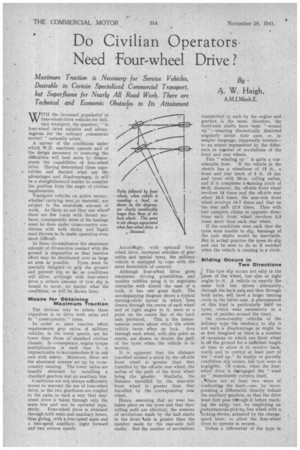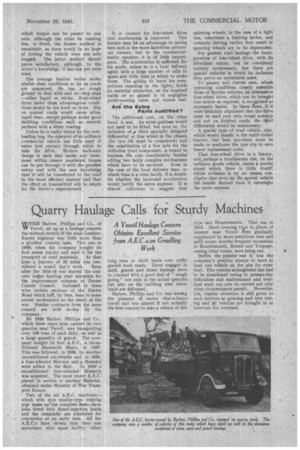Do Civilian Operators.
Page 28

Page 31

If you've noticed an error in this article please click here to report it so we can fix it.
Need Four-wheel Drive ?
By
4. W. Haigh, WITH the increased popularity/ of four-wheel-drive vehicles for military transport, the question; " Is four-wheel drive suitable and advantageous for the ordinary .,commercial motor? " naturally arises. A survey of the conditions under which W.D. machines operate and of the design necessary to overconr 'the difficulties will best serve to demon, strate the capabilities of four-wheel 'drive. Having determined these capa
• bilities and decided what are the advantages and disadvantages, it will • be a straightforward matter to consider the position from the angle of civilian requirements.
Transport vehicles on active service, whether carrying men or material, are subject to the maximutn amount of • work. As likely as not they run where' there are few roads with decent surfaces, consequently most of the haulage must be done under cross-country con . ditions with both sticky and liquid mud thrown in to make operation even more difficult.
In these circumstances the maximum amount of driven-tyre contact with the ground is imperative so that tractive effort may be distributed over as large an area as possible. Tyres must be specially designed to grip the ground and prevent slip so far as conditions will allow, although with four-wheel drive a certain amount of tyre slip is • bound to occur, no matter what the conditions, as will be shown later.
Means for Obtaining Maximum Traction The obvious way to attain these objectives is to drive both axles and fit " cross-countiy " tyres. In order to meet -tractive effort requirements gear ratios of military vehicles, in the lower speeds, are far • . lower than those of' standard civilian chassis, In consequence, engine. torque multiplication is such that it is impracticable to ticcommodate it in one axle with safety. Moreover, there are the abnormal stresses set up by crosscountry running. The lower ratios are
• usually obtained by installing a standard gearbox and an auxiliary box.
Conditions are not always sufficiently severe to warrant the use of four-wheel drive, so the two gearboxes are coupled to the axles in such a way that rearwheel drive is taken through only the main, box and can be operated separately. Four-wheel drive is obtained through both main and auxiliary boxes, thus giving, with a four-speed main and a two-speed auxiliary, eight forward . and two reverse speeds. Accordingly, with optional fourwheel drive, increased selection of gear ratios and special tyres, the military vehicle is equipped to cope with the most formidable of country.
Although four-wheel drive gives maximum driving possibilities and enables vehities using it to negotiate. obstacles with almost the ease of a tank, it has one great fault. The accompanying diagram shows a typical turning-circle' layout in which lines drawn through the centre of each wheel and at right angles to it, meet at a point on the centre line of the back axle. produced. This is the instantaneous centre about which the whole vehicle turns when on lock. Arcs through each wheel, with.this point as centre, are shown to denote the path of the tyres when. the vehicle is in motion.
It is apparent that the distance travelled around a circle by the off-side front wheel is 'greater than that travelled by the off-side rear wheel, the radius of the path of the front 1,Vheel being the greater. Similarly, the distance travelled by the near-side front wheel is greater than that travelled by the corresponding rea,r wheel.
Hence, assuming that no wear has, taken place on the tyres and that their rolling radii are identical, the number of revolutions made by the half shafts in the front oaxle is greater than the number made by the rear-axle half shafts. But the number of revolutions transmitted to each by the engine and gearbox is the same, therefore, the front-axle shafts have been "wound up "—meaning theoretically distorted angularly about their axes, or, in simpler language, supposedly twisted— to an extent represented by the difference in number of revolutions of the front and rear wheels.
This' winding winding up " is quite a con
siderable item. If the vehicle in the sketch has a wheelbase of 12 ft., a front and ,rear track of 5 ft. 10 ins: and tyres with 20-in, rolling radius, and if it completes a turning circle of 60-ft. diameter, the off-side front wheel revolves 18 times and the off-side rear wheel 16.5 times, the near-side front wheel revolves 14.7 times and that on the rear alfe 12.9 times. Thus with two complete circles in opposite directions each front wheel revolves S.S times more than each rear wheel.
If the conditions were such that the tyres were unable to slip, breakage of the axle shafts would be inevitable. But in actual practice the tyres do slip and can be seen to do so if watched when the vehicle is running in a circle.
Sliding Occurs in Two Directions
This tyre slip occurs not only in the plane of the wheel, but also at right angles to it. ,A vehicle on exactly the I. same lock but driven I alternately,
through the back axli and then through both axles, will have a larger turning circle in the latter case. A phenomenon of this kind is particularly hard on tyres, which wear excessively in a series of patches around the tread.
On cross-country vehicles of the military type the tendency to slip is not such a disadvantage as might be at first imagined as there is a number of occasions on which one front wheel is off the ground for a sufficient length.
of time to allow it to revolve backwards and to correct at least part of the "wind up." In muddy or gravelly conditions slip 'occurs, knit tyre wear is negligible. Of course, when the fourwheel drive is disengaged the "wind up " immediately corrects itself.
\ *There are at least two ways of eradicating the fault—one, by incor
porating a differential directly behind the auxiliary gearbox, so that the drive must first pass thtough-it before reaching the axles; two, by employing an ,instantaneou.s-pick-Up free wheel with a iocking device, actuated by the changespeed lever, to allow the four-wheel drive to operate in reverse.
. UnlDss a differential of the type in which torque can be passed to one axle, although the other be running free, is fitted, the former method is unsuitable, as there would he no hope of driving the vehicle were one axle bogged.. The latter method should prove satisfactory, although, to the writer's knowledge, it has not yet been tried.
The average haulier works under almost ideal conditions so far as roads are concerned. He has no rough ground to deal with and no deep mud —either liquid or sticky, Four-wheel drive under these advantageous conditions would be too hard on tyres. Slip on normal roads would cause ultrarapid wear, except perhaps under good skidding conditions such as smooth surfaces with a slimy coating.
Pnless he is badly bitten by the overloading bug, the operator of an ordinary commercial vehicle has little need of extra tyre contact through which to take his cliht. Modern back-axle design is such tkat under any treatment within reason maximum torque can be put through it with the greatest safety and with the sure knowledge that it will be transferred to the road in the most efficient manner and that the effort so transmitted will be ample for the driver's requirements. • It is claimed for four-wheel drive that acceleration is improved. This feature may be an advantage to racing men and. to the more fastidious privatecar owners, but to the commercialmotor operator it is of little importance. His acceleration is sufficient for his needs, unless he is a local delivery agent with a large number of calls to make and little time in which to make them. The ability, Co leave his competitors standing at the lights, holds no material attraction, as the hundred yards or so gained is of negligible profit-earning value and wastes fuel.
Are the Extra Parts Justified?
The additional cost, on the other hand, is real. An extra gearbox would not need to be fitted, but even so, the inclusion of .a. third specially designed differential or free wheel in the chassis (for tyre life must be considered) and the substitution of a live axle for the orthodox front component, is bound to increase the cost considerably besides adding two fairly complex mechanisms which have to be serviced. Even in the case of the local delivery man, to whom time is a vital factcir, it is doubtful whether the increased acceleration would justify the extra expense. It is almost ridiculous to suggest that spinning wheels, in' the case of a light van, constitute a limiting factor, and certainly driving tactics that result in spinning wheels are to be deprecated.
For general road haulage the incorporation of four-wheel drive, with its attendant extras, can be considered entirely unnecessary, but there are special vehicles in which its inclusion does prove an undeniable asset.
To quarry and timber men, whos operating conditions closely reSemble those of Service vehicles, an alternative four-wheel drive, which can be brought into action as required, is recognized as extremely useful. In these eases, if it were definitely stipulated that the drive must be used over only rough country and not on finished roads, the third differential would be unnecessary.
A special type of road vehicle, also, which would benefit is the multi-trailer -tractor, but here provision must be made to eradicate the tyre slip to save heavy replacement costs.
That four-wheel drive is a luxury, and,perhaps a troublesome one, on the ordinary goods vehicle, seems a matter about which there is little doubt: whilst evidence is by no means conclusive that even on tile special vehicle the benefit derived from it outweighs tlae extra expense.




















































